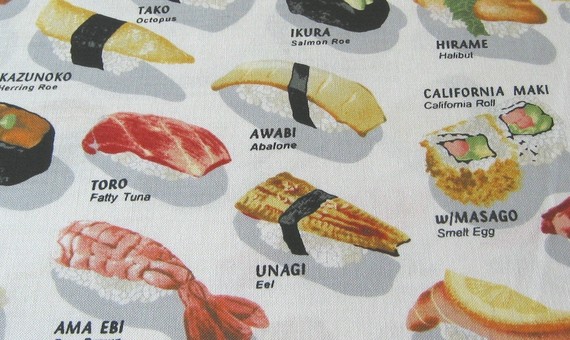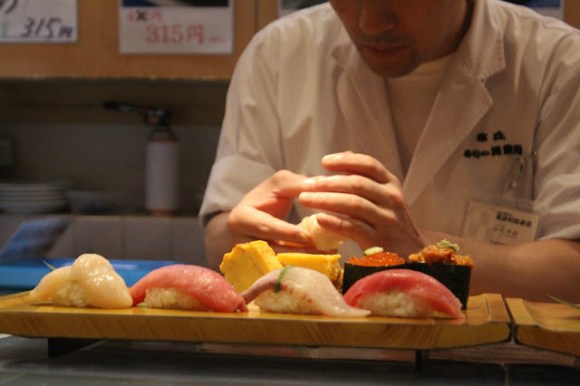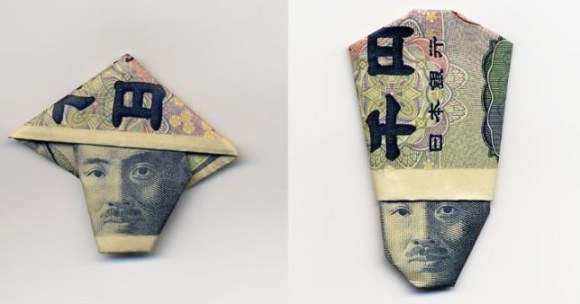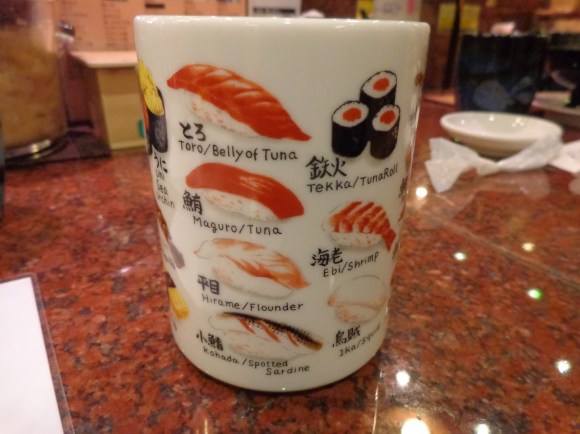
Japan’s sushi restaurants range from some of the finest cuisine in the world, to cheerful conveyer-belt gigs where everything is 100 yen (oh, alright then, 108 yen) and comes with a free toy. For those of us accustomed to the “sushi-go-round” that is kaiten-zushi, visiting a “proper” sushi restaurant in Japan where there’s no rotating belt of plates to choose from can be a daunting experience.
When there’s no menu, and you’re alone at the counter, quivering under the watchful eye of an intimidating chef armed with giant swishy blades, how do you order with confidence? Who better to ask than a sushi itamae, a high-end chef of Japanese cuisine. One of our intrepid Japanese reporters went to ask one of these top sushi chaps, who gave us his best three tips for sounding like you know what you’re doing at the counter.
▼ “Gimme something giant!!!” is probably not the right way to begin.
#3 – Name your price
When you visit a sushi restaurant in Japan, you can choose a set-priced o-makase (the chef’s choice; o-makase literally means “leave it up to you”). But you can also tell the chef how much you want to spend, instead. “Many people order the ‘special’ or ‘extra special’ o-makase, but when I hear someone name their own price instead and say ‘I’ll leave it up to you’, I know they know what they’re doing”, our expert says.
Telling the chef what your price-range is doesn’t necessarily mean you’re spending a lot – but it allows him to serve up as many delicious plates as you can afford. And in asking that of the chef, you’re also recognising and honouring his talent and experience. That’s what we call a win-win situation!
▼ It’s not about the money, money, money… (except for when it is).
#2 – Gimme what’s good today!
Similar to the o-makase, asking the chef to serve what’s fresh today is a sure-fire sign of a customer who knows their stuff. “When I hear that, I know I can’t serve them anything that’s a bit lacking”, explains our man. “It makes me nervous! But it also actually makes my job a bit easier, as I can just serve up what I think the best thing we have today is.”
▼ It’s pretty unlikely that you’ll get your green tea in a cup like this, but we reckon it’d be useful when ordering.
And finally, the number one tip, which as you might hope for from an expert in his field, is something of a wild card:
#1 – First off, order the cheapest nigiri on the menu
“When a first-time customer comes in alone and orders the nami nigiri [the cheapest chef’s selection of ordinary sushi], I’m 100 percent certain they know what they’re doing.” It might sound backwards, but ordering the nami (並 “ordinary”) instead of the more expensive jou (上, “special”) or tokujo (特上 “super-awesome special”), can actually work to single you out as a sushi pro. “If it’s good,” he explains, “you can keep ordering and try something more expensive, and if it’s no good, you can get the bill and go someplace else. That’s what people doing the rounds of different sushi restaurants do.”
Well there we have it! We’ve always felt a bit like a dirty skinflint ordering the nami every time, but it turns out we were signalling ourselves to be sushi experts! Now we can order sushi like a boss – which is to say, in unintimidated contentment.
Top image: luckykaerufabric/etsy
[ Read in Japanese ]




 Who’s got the best, cheapest one-person sushi delivery in downtown Tokyo? Mr. Sato investigates!
Who’s got the best, cheapest one-person sushi delivery in downtown Tokyo? Mr. Sato investigates! Learn how to make sushi with a professional Japanese sushi chef in Tokyo
Learn how to make sushi with a professional Japanese sushi chef in Tokyo Everything you need to know about dining at a sushi restaurant—in handy infographics!【Pics】
Everything you need to know about dining at a sushi restaurant—in handy infographics!【Pics】 This sushi restaurant’s take-home temakizushi set is insanely satisfying for a great price
This sushi restaurant’s take-home temakizushi set is insanely satisfying for a great price Japanese sushi chef samples the best cheap sushi the U.S. has to offer【Video】
Japanese sushi chef samples the best cheap sushi the U.S. has to offer【Video】 McDonald’s new Happy Meals offer up cute and practical Sanrio lifestyle goods
McDonald’s new Happy Meals offer up cute and practical Sanrio lifestyle goods All-you-can-drink Starbucks and amazing views part of Tokyo’s new 170 meter-high sky lounge
All-you-can-drink Starbucks and amazing views part of Tokyo’s new 170 meter-high sky lounge More foreign tourists than ever before in history visited Japan last month
More foreign tourists than ever before in history visited Japan last month Starbucks reopens at Shibuya Scramble Crossing with new look and design concept
Starbucks reopens at Shibuya Scramble Crossing with new look and design concept Beautiful Sailor Moon manhole cover coasters being given out for free by Tokyo tourist center
Beautiful Sailor Moon manhole cover coasters being given out for free by Tokyo tourist center Studio Ghibli glasses cases let anime characters keep an eye on your spectacles
Studio Ghibli glasses cases let anime characters keep an eye on your spectacles Tokyo luxury hotel offers month-long stays with free breakfasts, might be cheaper than apartment
Tokyo luxury hotel offers month-long stays with free breakfasts, might be cheaper than apartment Mister Donut ready to make hojicha dreams come true in latest collab with Kyoto tea merchant
Mister Donut ready to make hojicha dreams come true in latest collab with Kyoto tea merchant Hamster abandoned at Tokyo ramen restaurant gets new home
Hamster abandoned at Tokyo ramen restaurant gets new home Inflation making penguins in Japan unhappy with aquarium’s switch to cheaper fish
Inflation making penguins in Japan unhappy with aquarium’s switch to cheaper fish Disney princesses get official manga makeovers for Manga Princess Cafe opening in Tokyo
Disney princesses get official manga makeovers for Manga Princess Cafe opening in Tokyo Beautiful new Final Fantasy T-shirt collection on the way from Uniqlo【Photos】
Beautiful new Final Fantasy T-shirt collection on the way from Uniqlo【Photos】 Is the new Shinkansen Train Desk ticket worth it?
Is the new Shinkansen Train Desk ticket worth it? Foreign English teachers in Japan pick their favorite Japanese-language phrases【Survey】
Foreign English teachers in Japan pick their favorite Japanese-language phrases【Survey】 Japanese convenience store packs a whole bento into an onigiri rice ball
Japanese convenience store packs a whole bento into an onigiri rice ball We try out “Chan Ramen”, an underground type of ramen popular in the ramen community
We try out “Chan Ramen”, an underground type of ramen popular in the ramen community Studio Ghibli releases Kiki’s Delivery Service chocolate cake pouches in Japan
Studio Ghibli releases Kiki’s Delivery Service chocolate cake pouches in Japan Japan’s bone-breaking and record-breaking roller coaster is permanently shutting down
Japan’s bone-breaking and record-breaking roller coaster is permanently shutting down New definition of “Japanese whiskey” goes into effect to prevent fakes from fooling overseas buyers
New definition of “Japanese whiskey” goes into effect to prevent fakes from fooling overseas buyers Our Japanese reporter visits Costco in the U.S., finds super American and very Japanese things
Our Japanese reporter visits Costco in the U.S., finds super American and very Japanese things Studio Ghibli unveils Mother’s Day gift set that captures the love in My Neighbour Totoro
Studio Ghibli unveils Mother’s Day gift set that captures the love in My Neighbour Totoro Foreign passenger shoves conductor on one of the last full runs for Japan’s Thunderbird train
Foreign passenger shoves conductor on one of the last full runs for Japan’s Thunderbird train Domino’s Japan now sells…pizza ears?
Domino’s Japan now sells…pizza ears? New Japanese KitKat flavour stars Sanrio characters, including Hello Kitty
New Japanese KitKat flavour stars Sanrio characters, including Hello Kitty Kyoto creates new for-tourist buses to address overtourism with higher prices, faster rides
Kyoto creates new for-tourist buses to address overtourism with higher prices, faster rides Sales of Japan’s most convenient train ticket/shopping payment cards suspended indefinitely
Sales of Japan’s most convenient train ticket/shopping payment cards suspended indefinitely Sold-out Studio Ghibli desktop humidifiers are back so Totoro can help you through the dry season
Sold-out Studio Ghibli desktop humidifiers are back so Totoro can help you through the dry season Japanese government to make first change to romanization spelling rules since the 1950s
Japanese government to make first change to romanization spelling rules since the 1950s Ghibli founders Toshio Suzuki and Hayao Miyazaki contribute to Japanese whisky Totoro label design
Ghibli founders Toshio Suzuki and Hayao Miyazaki contribute to Japanese whisky Totoro label design Doraemon found buried at sea as scene from 1993 anime becomes real life【Photos】
Doraemon found buried at sea as scene from 1993 anime becomes real life【Photos】 Tokyo’s most famous Starbucks is closed
Tokyo’s most famous Starbucks is closed One Piece characters’ nationalities revealed, but fans have mixed opinions
One Piece characters’ nationalities revealed, but fans have mixed opinions We asked a Uniqlo employee what four things we should buy and their suggestions didn’t disappoint
We asked a Uniqlo employee what four things we should buy and their suggestions didn’t disappoint Princesses, fruits, and blacksmiths: Study reveals the 30 most unusual family names in Japan
Princesses, fruits, and blacksmiths: Study reveals the 30 most unusual family names in Japan Can’t go to conveyor belt sushi? Major Japanese chain will bring the conveyor belt to you!
Can’t go to conveyor belt sushi? Major Japanese chain will bring the conveyor belt to you! Master sushi chef effortlessly slices and dices vegetables while blindfolded【Video】
Master sushi chef effortlessly slices and dices vegetables while blindfolded【Video】 New Ginza sushi bar offers 21-piece omakase course for just US$60
New Ginza sushi bar offers 21-piece omakase course for just US$60 We try a rotating sushi restaurant in New Delhi, are surprised to find no rotating sushi
We try a rotating sushi restaurant in New Delhi, are surprised to find no rotating sushi There’s only one place in Japan where this kind of sushi isn’t red, but why?
There’s only one place in Japan where this kind of sushi isn’t red, but why? What should you use table salt for at a sushi restaurant? We asked a kaitenzushi maniac
What should you use table salt for at a sushi restaurant? We asked a kaitenzushi maniac Tokyo’s all-female sushi chef restaurant has closed down, is being dismantled
Tokyo’s all-female sushi chef restaurant has closed down, is being dismantled Will virtual plate procession become the new normal for conveyor belt sushi restaurants in Japan?
Will virtual plate procession become the new normal for conveyor belt sushi restaurants in Japan? Is it gross to eat sushi that the chef pressed with his bare hands?【Survey】
Is it gross to eat sushi that the chef pressed with his bare hands?【Survey】 Does how you dress affect what a sushi restaurant serves you? We experiment in Ginza
Does how you dress affect what a sushi restaurant serves you? We experiment in Ginza Conveyor belt sushi chain taking the bold, eco-friendly step of getting rid of all its conveyors
Conveyor belt sushi chain taking the bold, eco-friendly step of getting rid of all its conveyors Clever home sushi-making set puts a whole new spin on revolving sushi
Clever home sushi-making set puts a whole new spin on revolving sushi Nadeshico Sushi restaurant challenges gender roles with all-female staff clad in kimono
Nadeshico Sushi restaurant challenges gender roles with all-female staff clad in kimono What time of day gets you the best-tasting sushi at a revolving sushi restaurant?
What time of day gets you the best-tasting sushi at a revolving sushi restaurant? Upcoming Nintendo game lets you eat sushi, destroy enemies with stacks of sushi plates 【Video】
Upcoming Nintendo game lets you eat sushi, destroy enemies with stacks of sushi plates 【Video】 Here’s what a 10,000-yen Sushi Cake from Japan looks like
Here’s what a 10,000-yen Sushi Cake from Japan looks like
Leave a Reply